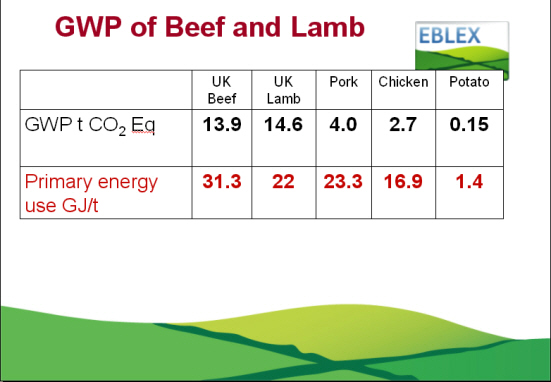



Roadmap to Cutting Livestock Emissions
UK agriculture will have to find savings equivalent to 3 million tonnes of CO2 a year between now and 2020 to achieve the government's emissions reduction targets, writes TheCattleSite senior editor, Chris Harris.The targets have been set out in the UK Low Carbon Transition Plan that lays down the strategy for meeting the greenhouse gas emission reductions of the 2008 Climate Change Act.
To meet the targets for the ruminant livestock sector, the English Beef and Lamb Executive has been working on a roadmap to give guidelines to the industry in ways it can meet the targets.
EBLEX has sought to achieve the reductions by measuring gains in efficiency in production rather than reducing the numbers of livestock.
By reducing livestock in the UK the problem would just be transferred elsewhere, but EBLEX says that naturally falling numbers of beef cattle and sheep driven by economic factors will deliver savings in the greenhouse gases per kilogram of meat over the next 10 years.
"Beef suckler, dairy cow and ewe numbers are forecast to continue declining in the coming decade due to the decoupling of support payments, competition with more profitable enterprises, problems in securing labour and fewer family successions," EBLEX says in its roadmap report, Change in the Air.
"This will result in a continued reduction in both beef and sheep slaughterings and domestic production levels."
The report shows that there has already been a steady improvement in production methods with now five per cent fewer animals needed to produce each tonne of meat.
"This and the progressive reduction in both breeding and slaughter stock numbers over the past 10 years, has undoubtedly contributed to substantial reductions in GHG emissions recorded," the report says.
The report shows that English beef production currently generates a Global Warming Potential (GWP100) of around 13.9kg of CO2 equivalent and is consuming just over 31 MJ of primary energy per kilogram of meat produced.



The report says that this can be broken down into the different areas of production - lowland suckler beef, hill and upland suckler beef and dairy beef - for practical target setting.
The report says that there are distinct advantages for dairy beef production, as the calves for beef production are a by-product of the primary focus of the industry and also because the sector tends to be more intensive in its nature.
The global warming potential tends to increase the more extensive the production methods, because more animals are required to produce each tonne of meat and lower quality forages tend to generate more methane.
For the beef and sheep sectors to reduce their CO2 equivalent emissions by the target of 11 per cent, EBLEX has calculated that the industry needs to achieve about 1kg of CO2 equivalent reduction per kilogram of beef and sheep meat produced.
And because of the different nature of the productions systems for lowland, hill and upland and dairy beef production, different targets need to be established for each.
The report shows that the targets could be achieved by a number of combinations of changes to feeding regimes and improvements in fertility.
It shows that the middle path of achieving higher daily liveweight gain of 0.32kg/day through increased feed efficiency and also by increasing the numbers of calves born per cow per year by 0.05 by 2020, would achieve the CO2 equivalent reductions required.
"However, greater gains in fertility efficiency would decrease the level of feeding efficiency improvements necessary and vice versa," the report says.
The report concludes that emissions reduction in the beef and sheep sector needs to be based firmly on improved production efficiency and the three main areas that need to be addressed are breeding, feeding and management in order to achieve the feed efficiency required.
The industry also has to look at performance traits in the breeds to achieve worthwhile improvements in characteristics.
Better use of forage and more accurate rationing to reduce waste will help optimise performance.
EBLEX said that by improving performance, the measures taken to reduce greenhouse gas will also help to improve the general management and production and increase sustainability on the farm.
"Improving housing conditions, and access to feed and water, as well as reducing clinical and sub-clinical levels of disease, offer further opportunities for greater efficiency," the report says.
One of the authors of the report, Dr Duncan Pullar from EBLEX said: "As an industry we have to own this issue. We can and should make a contribution to reducing the carbon footprint of production."
Further Reading
| - | You can view the full report by clicking here. |
December 2009


